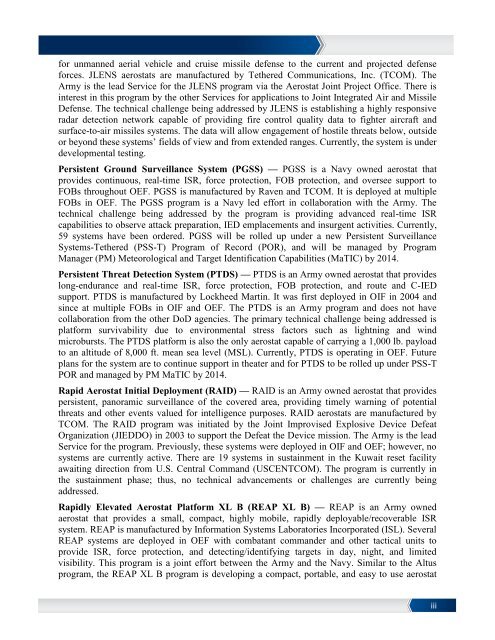lighter-than-air vehicles - Defense Innovation Marketplace
lighter-than-air vehicles - Defense Innovation Marketplace
lighter-than-air vehicles - Defense Innovation Marketplace
You also want an ePaper? Increase the reach of your titles
YUMPU automatically turns print PDFs into web optimized ePapers that Google loves.
for unmanned aerial vehicle and cruise missile defense to the current and projected defenseforces. JLENS aerostats are manufactured by Tethered Communications, Inc. (TCOM). TheArmy is the lead Service for the JLENS program via the Aerostat Joint Project Office. There isinterest in this program by the other Services for applications to Joint Integrated Air and Missile<strong>Defense</strong>. The technical challenge being addressed by JLENS is establishing a highly responsiveradar detection network capable of providing fire control quality data to fighter <strong>air</strong>craft andsurface-to-<strong>air</strong> missiles systems. The data will allow engagement of hostile threats below, outsideor beyond these systems’ fields of view and from extended ranges. Currently, the system is underdevelopmental testing.Persistent Ground Surveillance System (PGSS) — PGSS is a Navy owned aerostat thatprovides continuous, real-time ISR, force protection, FOB protection, and oversee support toFOBs throughout OEF. PGSS is manufactured by Raven and TCOM. It is deployed at multipleFOBs in OEF. The PGSS program is a Navy led effort in collaboration with the Army. Thetechnical challenge being addressed by the program is providing advanced real-time ISRcapabilities to observe attack preparation, IED emplacements and insurgent activities. Currently,59 systems have been ordered. PGSS will be rolled up under a new Persistent SurveillanceSystems-Tethered (PSS-T) Program of Record (POR), and will be managed by ProgramManager (PM) Meteorological and Target Identification Capabilities (MaTIC) by 2014.Persistent Threat Detection System (PTDS) — PTDS is an Army owned aerostat that provideslong-endurance and real-time ISR, force protection, FOB protection, and route and C-IEDsupport. PTDS is manufactured by Lockheed Martin. It was first deployed in OIF in 2004 andsince at multiple FOBs in OIF and OEF. The PTDS is an Army program and does not havecollaboration from the other DoD agencies. The primary technical challenge being addressed isplatform survivability due to environmental stress factors such as lightning and windmicrobursts. The PTDS platform is also the only aerostat capable of carrying a 1,000 lb. payloadto an altitude of 8,000 ft. mean sea level (MSL). Currently, PTDS is operating in OEF. Futureplans for the system are to continue support in theater and for PTDS to be rolled up under PSS-TPOR and managed by PM MaTIC by 2014.Rapid Aerostat Initial Deployment (RAID) — RAID is an Army owned aerostat that providespersistent, panoramic surveillance of the covered area, providing timely warning of potentialthreats and other events valued for intelligence purposes. RAID aerostats are manufactured byTCOM. The RAID program was initiated by the Joint Improvised Explosive Device DefeatOrganization (JIEDDO) in 2003 to support the Defeat the Device mission. The Army is the leadService for the program. Previously, these systems were deployed in OIF and OEF; however, nosystems are currently active. There are 19 systems in sustainment in the Kuwait reset facilityawaiting direction from U.S. Central Command (USCENTCOM). The program is currently inthe sustainment phase; thus, no technical advancements or challenges are currently beingaddressed.Rapidly Elevated Aerostat Platform XL B (REAP XL B) — REAP is an Army ownedaerostat that provides a small, compact, highly mobile, rapidly deployable/recoverable ISRsystem. REAP is manufactured by Information Systems Laboratories Incorporated (ISL). SeveralREAP systems are deployed in OEF with combatant commander and other tactical units toprovide ISR, force protection, and detecting/identifying targets in day, night, and limitedvisibility. This program is a joint effort between the Army and the Navy. Similar to the Altusprogram, the REAP XL B program is developing a compact, portable, and easy to use aerostatiii

















